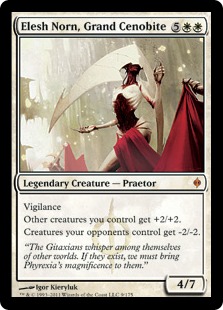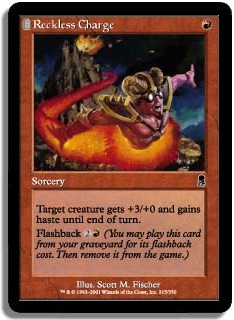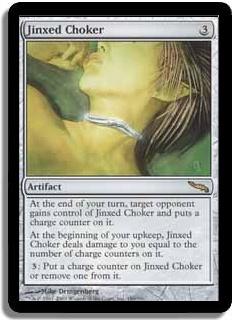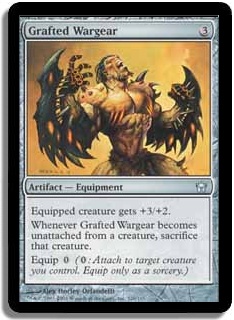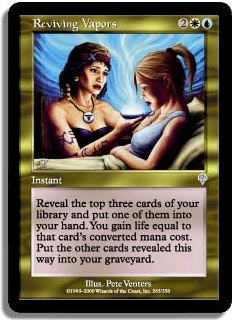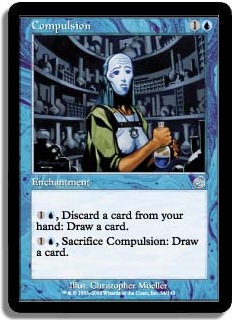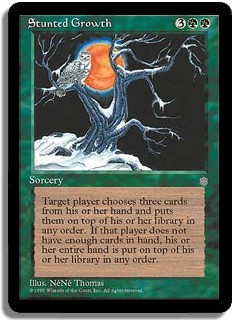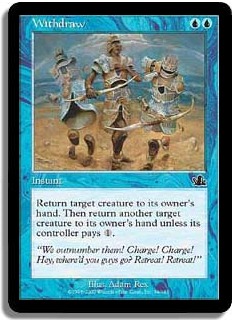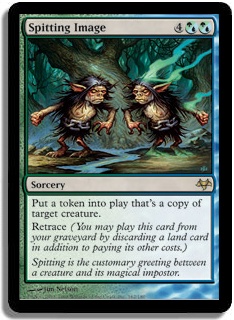Ah, I see I didn’t scare too many of you away with my last article about which cards have overstayed their welcome in most cubes. I got tons and tons of feedback for last time, so I’m glad so many of you agreed/disagreed/wanted-to-bang-your-head-against-a-wall! Your feedback is what makes me most excited when I sit down to type out each article.
Even though I love talking to myself about Cube (and do quite often), I love talking to everyone else about Cube even more. So if you have any opinion at all or feedback on what you think, please let me know in the comments, on Facebook, Twitter, a carrier pigeon, Carrier Pigeons, or even old fashioned paper mail (read: please don’t send me mail); I’d love to talk about Cube with you!
Now before we get into the meat of the article today, I do want to reiterate that I understand that many of you have these cards in your cube, but that doesn’t mean that everyone has these cards in their cubes. So, like everything related to Cube, YMMV (your mileage may vary). I know you can certainly find something useful below!
1. Elesh Norn, Grand Cenobite
I have to admit, I did not initially jump on the Elesh Norn bandwagon. I saw what all of you doubters see; an over costed fatty that isn’t all that fat, maybe making some of my opponent’s smaller dudes hit the graveyard if there are any still left around turn 7 or beyond. Why would I play a seven-drop that kills in five hits?
Out of every card on this list, I don’t think my initial reaction could have been more wrong (of course, this is the only card listed that came out after I first put my cube together, but I digress). I feel like Norn is the most ubiquitous now of all on this list, but I know there are still some holdouts, so let me allay some of your concerns.
For a very very high percentage of cubes, most creatures included are done so because of their value one way or another. Either an enters the battlefield effect (Acidic Slime, Bloodbraid Elf, Snapcaster Mage), a continuous effect (Dark Confidant, Thalia, Grim Lavamancer), or size/evasion compared to their casting cost (Tarmogoyf, Baneslayer Angel, most other creatures) are what makes them special, or cube-able, at all.
Elesh Norn affects every creature on the board. It’s difficult to wrap your head around, but most games end with a player being attacked to death by a couple of small creatures after their effect or backup spells clear the way long enough to bruise the opponent with a couple of successful combat steps. At every point in the game, Norn stops those creatures from attacking for the ones that make a living off of size versus cost and most utility dudes even existing. She’s a Plague Wind that stops your opponent from playing any more creatures or tokens.
For those of you that play Constructed formats where she is A Card, like Standard or Legacy, her interactions mimic those formats. She must be removed from the battlefield immediately or the game ends for the most part if not all together. I don’t know of another creature you can reasonably cast that you can say that about.
That doesn’t take into consideration that she turns every other creature or token generator you control into a monster, even if they started as simple 1/1s. The trick is, as always, to live to cast her (unless you shortcut it, which needless to say is game breaking), but any mid-range or control deck worth its salt should be able to live to cast the Cruel Ultimatum of creatures.
2. Reckless Charge
If you’re on the side of the impending Norn destruction, you want to destroy your fatty loving opponent before he or she has a chance to make your life a living hell. Since the beginning of time, the best way to do that has been granting a creature the second best ability it can have in haste (the first being flash of course, or “blue haste”). The flashback is what makes this card excellent of course.
Though a fair number of red creatures don’t have haste, usually given that their power comes from having a different ability, the best situation is often when this card is paired with green or white where only a couple do. Even when you aren’t giving a creature haste, Reckless Charge often acts as an additional Lightning Bolt with flashback. The times when it’s the scariest for your opponent are the mid to late game when it hasn’t been cast and any creature you rip turns into a +6/+0 hasty monster.
The Charge was in my initial cube list before I incorrectly took it out for new cards, and I have since noted the numerous times I’ve wanted the effect. Don’t be fooled by its simple appearance; this card steals tons of games, even when you’re opponent thinks they’re prepared for it.
3. Jinxed Choker
Another card that I mistakenly took out of my cube was Jinxed Choker, also known as Sulfuric Vortex Jr. Ironically I took out the Choker for Isochron Scepter for its first tour of duty, and when Scepter made its way out, the Choker somehow stayed on the sidelines. The two cards couldn’t be more different, but I’m not just talking about effect. Scepter is a classic example of a card that requires other cards to be even remotely playable, whereas all the Choker needs is a deck that is interested in reducing the opponent’s life total to zero as fast as possible.
One of my favorite things about this card is that it, like Fact or Fiction, gives your opponent opportunities to make mistakes. When you cast this card, treat it like Vortex and basically ignore it (or dumping mana into it when you have no play), and give it to your opponent, they’re faced with the decision every turn of trying to take off counters or furthering their game plan. Even when they make the right decision, you still get your two damage or so a turn out of them or make them waste time and mana trying to reverse the Choker.
It obviously doesn’t have the “no life gain” anti-escape clause, but it does fit beautifully into your non-red aggro decks where reach can sometimes be difficult to have to deal those last four points of damage. If you’re looking for a way to improve aggro across the board, this is it.
4. Who / What / When / Where / Why
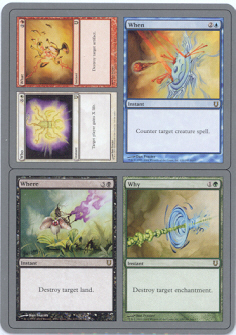
I literally saw some of you scoff as you scrolled down the page! What, because this is a silver bordered card it can’t go in your high-class cube? Open your mind! This card is (obviously) obscenely versatile, and even though I’ve had it in my cube since its inception, it still doesn’t get the respect it deserves. I almost always want to have access to this card in a deck where I’m two colors, and if I’m three plus I always want access to this card. I probably only maindeck it 75% of the time, but there’s always a chance to side it in.
If you want to have your cube be free of silver borders, I guess I get it from a nostalgia standpoint. But you should rid yourself of the silly notion that some of these cards are just for laughs, because a handful of them (Booster Tutor, Frazzled Editor, Blast from the Past, City of Ass) are excellent cards regardless of border. W/W/W/W/W is the most real of any, and it’s just as much a Magic card as any you’d have in a cube. There isn’t any goofiness going on; it’s just a very solid split card. Don’t let your cube suffer and make room for this masterpiece.
5. Grafted Wargear
Like Jinxed Choker, this was another former cube casualty that was previously in my cube but lost out to the newer (and still admittedly better) Sword of Body and Mind. I won’t be taking out the Sword, but after playing with this card more and beating down numerous bodies, my mind has changed. Wargear is brutal and elegant with a minimal “downside.”
Considering the only time I’ve seen a creature purposely unequipped from the Wargear was to bin it for Reanimator shenanigans, I would say that this equipment is aggression personified. Curving into Wargear can sometimes be game over for an opponent, be it another aggro deck or especially a control deck. A permanent Giant Growth is a steal at three colorless mana.
I will admit that occasionally Grafted Wargear gets blown up and takes your guy with it, but I managed to avoid obviously poor scenarios in the last installment, so I won’t say much more than that about it. Just know that the upside of this card far outweighs the downside. It plays infinitely better than it looks on paper.
6. Reviving Vapors
Reviving Vapors is another gem that always manages to get overlooked. I’ve never played with any cubes that have rares in them that also have this card other than my own (though I’m sure I’m not alone in my love for the Vapors), so in this case I’ll talk about mainly my cube in regards to why this is an awesome card.
I like to attack with creatures. I also like to see other people attack with creatures, especially in my cube. I wholeheartedly believe that if you want to have a balanced cube, you need to go out of your way to make aggro as viable as possible. Control and midrange strategies basically build themselves, because it isn’t difficult to grab any cards you want to jam in a deck if you don’t have to be fearful of aggressive decks. Now I’m not the first person to say that; I’m sure you’ve heard that before in some form or fashion, and I won’t be the last. So what does all of this talk about aggro have to do with a card that is clearly tailored to control?
I want control decks to have access to cards that can be more interactive than less interactive. This is the reason I have cards like Reviving Vapors and Ghostly Prison in my cube rather than Wall of Denial and Moat. You’re probably saying, “Those cards don’t interact either!” and to that I would say you are wrong.
Any card that forces someone to make a decision based on what the opponent is doing is an interaction, and Vapors and Prison do that. The former has you picking if you want the best card for the situation or the most life as well as interacting well with the graveyard, and the latter makes your opponent choose how to spend his mana each turn. With Wall of Denial and Moat, you play them and forget about them. Once they’re on the battlefield, the decisions are made until they aren’t sitting there anymore.
Is Reviving Vapors more powerful than a Wall of Denial or similar control oriented spell that resides in the white/blue section of your cube? Not necessarily, but I don’t think it’s worse either. I like to draw cards at instant speed and gain life when I’m facing down an aggressive deck. This card does both wrapped in a neat little package. It doesn’t overwhelm you with power, but it does exactly what you want it to at (more importantly) the speed you want it to. Give it a shot!
7. Compulsion
I’m frustrated at myself for not putting this into my cube any sooner than I did. I still had four foil copies from its time a Mirari’s Wake deck from a Standard format many moons ago, and I absolutely loved everything it did. It provided a hard to remove looter at the cost of a couple of mana a turn, obviously interacted with the graveyard, and when you needed it to, traded itself in for an extra card. So what made this a non-candidate for a spot in the Parnell Cube Resort?
Uhh…nothing.
Well, stubbornness I guess.
Looters are always difficult to evaluate in Cube. The creature ones that are reasonably costed always seem to be so fragile, and they really have to hit the sweet spot of two mana or less to be considered for Cube. Most often they don’t make lists, as removal is certainly more abundant in well-constructed cubes (which constitutes all of my brilliant readers), making the looters a risky proposition. The last thing a creature light deck wants is to turn on the opponent’s removal, as most would want to use that card slot for a harder to kill dude or spell that gets them to their end game.
Compulsion sidesteps these issues. It’s not without flaws, as the two-mana-to-loot cost is something that can’t be overlooked, and some decks want to be able to spend their mana during their turns actually doing things.
However, in true control decks Compulsion takes over the game quickly. Being able to loot multiple times a turn occasionally feels like cheating when you’re able to sculpt your hand at instant speed without much interference from the opposition. Not to mention this is the stone nuts with Living Death. I know that Compulsion looks underwhelming, but this is a card you can’t appreciate until you see it in action. Since you won’t be cubing with my cube anytime soon, looks like you’ll have to give it a shot to see for yourself!
8. Stunted Growth
Stunted Growth was recommended to me by my friend Paul Hayworth about three years ago. People recommend cards to me all the time, asking why such and such isn’t in my cube. Usually I have a reason—I’d already tried it, it’s simply not good enough, etc. Stunted Growth is the rare case when I had nothing to say. Why was Plow Under’s older but less heralded cousin in my cube?
If you’ve ever cast Plow Under, you know how absurd it can be. If you haven’t, go do it. Yes, now! Okay good. Now copy it with Chandra, the Firebrand (sorry Reuben). Okay, now that we’ve all cast Plow Under, imagine having two of those in a deck. Stunted Growth is swingier than the Plow since it can “miss” if an opponent is empty handed (or my preferred term), whereas it’s pretty uncommon for there to be no lands to target when you can cast a spell. Even still, most of the time Growth has the same type of effect, effectively being a green Time Walk (or two.)
I’ve always felt like green in Cube is constantly going through an identity crisis, not knowing where it should fall. Is it the fixing color? Does it support aggro? Ramp? Is it the best support color? The worst? Does its curve start at one and then skip to four? Green feels so different in every cube, as the answers to all of those questions are going to vary greatly depending on who you ask.
I think green needs cards like Stunted Growth; things that are decidedly green that are completely unique effects. Even though we’ve been getting more and more recently for the so-called “worst color in Cube,” that doesn’t mean we can’t reach into the past to find an underused, ultra-powerful spell.
9. Withdraw
Withdraw is one of the most powerful bounce spells available, yet it’s rarely seen outside of common/uncommon cube lists and is still not widespread there. What would it cost for a spell to bounce two creatures at instant speed? Undo costs three, so making it instant speed should cost one more, and neither of those cards would be cube-able.
But what about one less? I know that there’s the “unless you pay 1” clause like one Crystal Shard or Erratic Portal, but you almost always can bounce a creature when you first cast the artifact. Withdraw is no different, except your opponent doesn’t know you’re going to cast it, setting him back two turns.
The UU in Withdraw’s cost often isn’t an issue, as like all bounce spells it remains live the whole game. The supposed drawback is easily mitigated too. If your savvy opponent keeps an extra mana open the whole game, good for you, but you can always block, bounce his guy unconditionally, and bounce your guy unless you pay one. This is a pretty common play with Withdraw and is a good amount of value on a card that just costs two.
10. Spitting Image
Good ol’ Spittin Image. There was a time before there were 20+ planeswalkers in every cube when I would consider Spitting Image to be a Top 10 card in cubes without power. If you take out the planeswalkers, I still feel that way. Spitting Image can absolutely take over games. There isn’t a rider on that sentence either. I didn’t forget to say if left unchecked or in some situations. Nope, if you have six mana and a land or two in hand, prepare to be rewarded.
One of the most beautiful things about this card is its casting cost. The double hybrid green/blue mana makes this game changer super easy to cast. It’s even  in colors that care about lands by interacting with them the best and having a surplus (green) and draw a crap ton of cards resulting in extra (blue). The only downside to this card is it won’t even be able to target shroud or hexproof creatures, so you’ll have to find another way to interact/play real Magic with that Thrun, the Last Troll or Geist of Saint Traft.
Even with the advent of planeswalkers, Image feels like one itself that you pay mana for every turn rather than loyalty. The ability to continue to copy the best creature is ultra-powerful, and oftentimes two copies is all it takes to make the game out of reach, especially with the threat of turning every land draw into one of the best spells in your deck.
Thanks again for checking in to get your Cube fix. As always, let’s take a look at a sweet cube deck, this time drafted by my friend Puddles. (Yes, that’s his real name. His mom called him that once, so that legally changed it.)
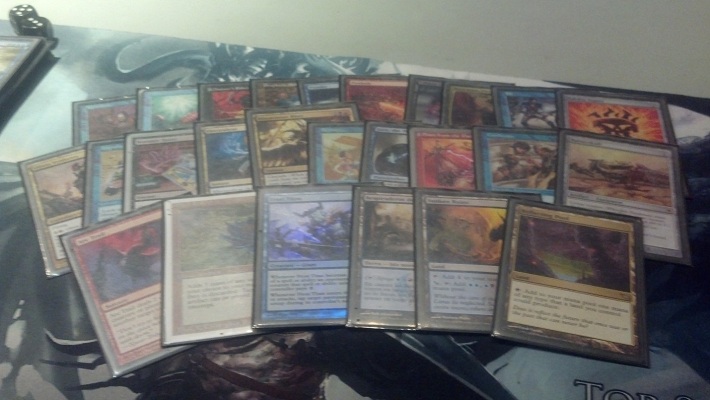
Remember to leave your feedback of all variety below. I always love to hear from you all. Make sure to check out the article from Ali and myself about our Custom Cube Project, right here on SCG. Don’t forget to watch the accompanying video features done masterfully by Michael Mirrielees over at Seems Good Radio TV.
Justin Parnell
@JParnell1 on Twitter
Official Facebook Cube Drafting Page
My and Ali Aintrazi‘s Custom Cube Project Facebook Page
MY CUBE HOME

